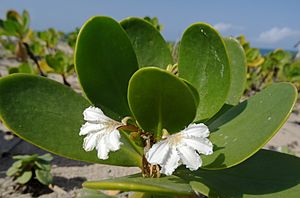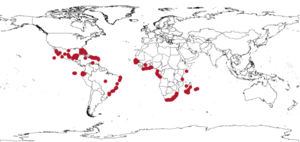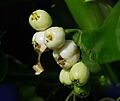Scaevola plumieri facts for kids
Quick facts for kids Scaevola plumieri |
|
|---|---|
 |
|
| Xai-Xai beach (Mozambique) | |
| Conservation status | |
| Scientific classification | |
| Genus: |
Scaevola (plant)
|
| Species: |
plumieri
|
 |
|
| Occurrence data from GBIF | |
| Synonyms | |
|
Lobelia plumieri L. |
|
Scaevola plumieri is a special plant often called gullfeed. It's a type of plant that grows on sandy coasts in warm, tropical, and subtropical places around the world. It belongs to the plant family called Goodeniaceae.
Contents
About the Gullfeed Plant
The Scaevola plumieri is an evergreen shrub. This means it's a bushy plant that stays green all year long. It has many branches.
Its leaves are thick and juicy, like a succulent plant. You'll find these leaves at the very ends of its branches. As the plant grows, it sheds older leaves below the tips. This leaves small marks on its yellowish-green stems.
The leaves can be attached directly to the stem (stalkless). Or they might have a flat, winged stalk. They are shaped like an upside-down egg, about 5 to 11 centimeters long and 2 to 7 centimeters wide. Their edges are smooth. You might not easily see the small veins on the leaves.
Flowers and Fruit
The flowers of the gullfeed plant grow in small clusters called cymes. These clusters appear where the leaves meet the stem. Each cluster can have one to seven flowers.
The flowers are usually white or greenish. They have a tube-like part that is about 10 to 12 millimeters long. Inside this tube, there are many tiny hairs.
After the flowers bloom, the plant produces a fleshy fruit. This fruit is blue or black and is about 10 to 15 millimeters wide. The seeds inside the fruit do not spread out on their own.
Comparing with Similar Plants
Scaevola plumieri looks a lot like another plant called Scaevola taccada. For a long time, scientists thought they were the same plant!
But there are a few ways to tell them apart:
- S. plumieri has very short or no calyx lobes. The calyx is the green part that covers the flower bud. Its ripe fruit is black.
- S. taccada has clear calyx lobes that stay on the fruit. Its ripe fruit is white.
Plant History and Naming
The Scaevola plumieri plant was first described by a famous scientist named Carl Linnaeus in 1753. He first called it Lobelia plumierii.
Later, Linnaeus thought this plant was special enough to be the only one in a new group, or genus, he named Scaevola. However, it was another scientist, Martin Vahl, who officially published the name Scaevola plumieri in 1791.
Where the Gullfeed Plant Lives
You can find Scaevola plumieri growing in many coastal areas around the world. It loves sandy beaches and sand dunes.
It grows along the coasts of East Africa, from Somalia all the way down to South Africa. It's also found on the West African coast, from S. Tomé to Angola. You can see it in Sri Lanka and in tropical parts of America, south of Florida.
Images for kids






